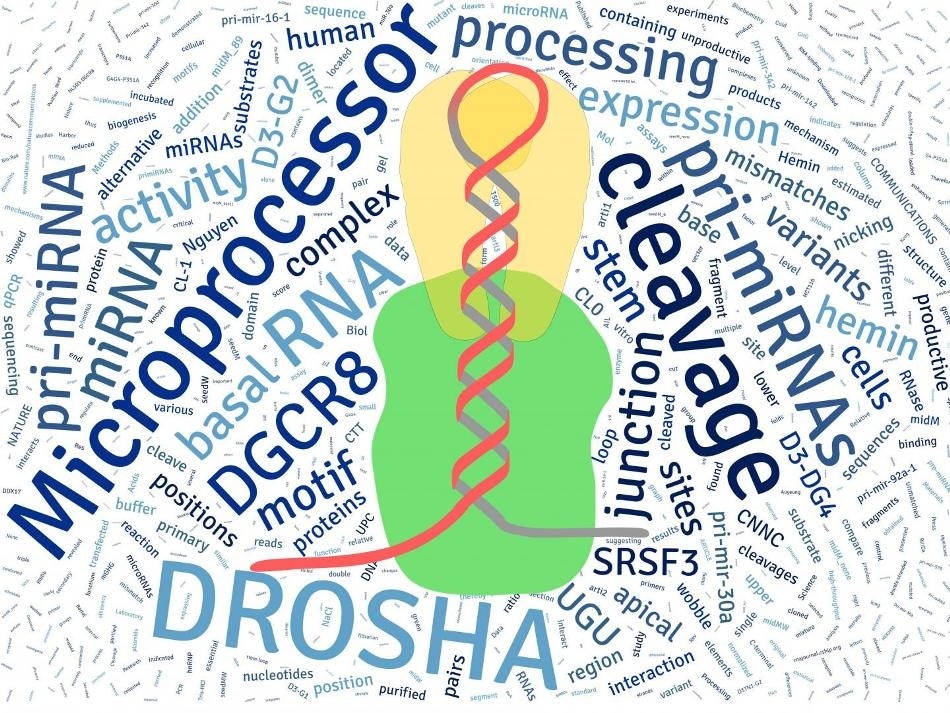In all the organisms, including humans, proteins are encoded by genes and these proteins, in turn, control the body’s diverse specific cellular functions.

The model of Microprocessor on pri-miRNA. Pri-miRNA is illustrated with ribbons. Microprocessor is a trimeric complex, consisting of DROSHA (green) and DGCR8 dimer (yellow). The background is the word cloud generated using our lab’s publications since 2018. Image Credit: The Hong Kong University of Science and Technology.
Human DNA contains genetic data that is initially changed into messenger RNA, or mRNA, through a process known as transcription.
This mRNA serves as a template since it is read by ribosomes, which are intracellular organelles. These ribosomes, in turn, translate or create a suitable protein from the right amino acid components.
The short non-coding RNAs called miRNAs do not produce any protein but definitely play vital roles in controlling the stability of mRNAs as well as their conversion to proteins.
Moreover, miRNAs’ abnormal expression is also linked with several human diseases, like different types of cancer caused by miRNA defects, resulting in decreased levels of tumor suppressor mRNAs and increased levels of oncogenic mRNAs.
Therefore, having the potential to exploit the production of miRNAs in cells is very important for developing treatments to rectify the defects in their expression and thus treat those disorders.
To sustain normal cellular functions, the expression of miRNAs should be rigorously regulated. The human Microprocessor complex plays a major role in cleaving the pri-miRNAs to create miRNA precursors or pre-miRNAs, and since it eventually establishes the role of miRNAs, it became the focus of this study.
Several RNA elements situated in certain parts of the pri-miRNA structure (that is, the apical loop, lower stem, and basal segment) have earlier been revealed to influence the processing of pri-miRNA by the human Microprocessor.
But a long-standing enigma was whether any RNA elements are present in the upper stem region of pri-miRNA and whether these elements are likely to have an impact on the Microprocessor’s cleavage ability and thus the following cellular processes.
A team of researchers, headed by Tuan Anh NGUYEN, an Assistant Professor in the Division of Life Science at Hong Kong University of Science and Technology (HKUST), has now identified how the RNA elements located in the upper stem of pri-mRNAs influence the Microprocessor’s action.
In this research, the researchers used human cells to initially establish a reliable protein purification system and subsequently performed high-throughput enzymology assays to study the catalytic mechanism of Microprocessor as it cleaved about 200,000 randomized pri-miRNAs.
Then, using next-generation sequencing technology, they ran the assay results and the resultant big data were examined using a range of bioinformatics tools. At last, the outcomes of big data analysis were validated in human cells.
Along with his team, Prof. NGUYEN identified multiple RNA elements in the upper stem of the pri-mRNAs, which are important for controlling the expression of numerous miRNAs present in human cells.
The presence of such elements implied that upon cleaving the pri-mRNAs with Microprocessor, fewer products were developed or different alternative cleavage sites were created rather than the original sites.
These had an impact on the miRNAs’ expression level, leading to the dysregulation of the following production of proteins from mRNAs and thus resulting in abnormal human cell activities.
Our work has enhanced our understanding about the differential levels of miRNAs in diverse cellular processes. Our new results may help us interpret the cause of many miRNA-related human diseases. Also, by specifically targeting the particular RNA elements we’ve identified, we should be able to restore the normal levels of many abnormally-expressing miRNAs in many miRNA-related disorders, leading to the potential development of clinical miRNA-based diagnostics.”
Shaohua LI, Study Co-First Author, Hong Kong University of Science and Technology
Tuan Anh NGUYEN, the other co-first author of the study, added, “Our next step is to develop our high-throughput enzymology assays by designing new RNA substrates, and engineering proteins to identify more RNAs elements that are critical for accurate and efficient miRNA production.”
Last month, my team and I published another paper, this time in Nucleic Acids Research, where we discovered other new and exciting RNA elements that control miRNA levels. We are currently using different approaches, including gene-editing technology, to modify the RNA elements we discovered in these two studies, in order to more accurately control the level of miRNAs in cellular systems.”
Tuan Anh NGUYEN, Assistant Professor, Division of Life Science, Hong Kong University of Science and Technology
“The expected outcome from this study will be to lay the foundation for the future development of this RNA element-targeting therapeutics for miRNA-related diseases,” NGUYEN concluded.
Source:
Journal reference:
Li, S., et al. (2020) Mismatched and wobble base pairs govern primary microRNA processing by human Microprocessor. Nature Communications. doi.org/10.1038/s41467-020-15674-2.